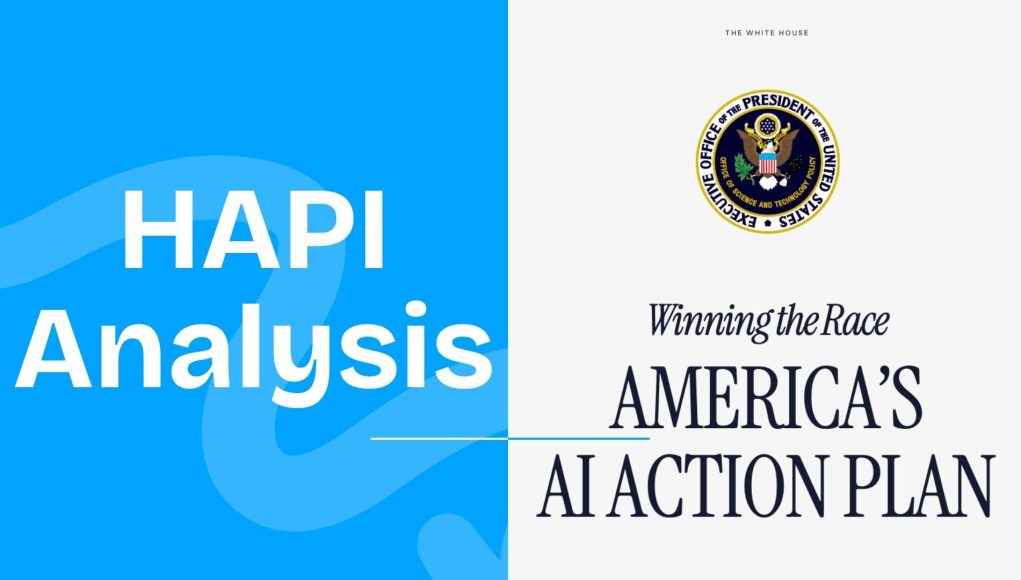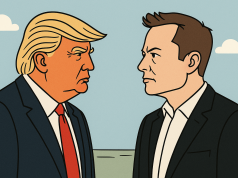When Policy Roars, But People Whisper
In the quiet corners of a forest, evolution doesn’t happen with fanfare. It’s in the silent twist of a vine reaching new light, or a fox changing its hunting hours as the climate warms. Adaptability isn’t a choice—it’s nature’s imperative.
So when national AI strategies trumpet phrases like dominance, renaissance, and technological supremacy, I hear echoes of another kind: Are our people—our communities, our workers—evolving in sync with the tech we build? Or are we launching rockets while forgetting to train astronauts?
The “America’s AI Action Plan,” released in July 2025, is an ambitious outline of AI-led progress. It covers infrastructure, innovation, and international positioning. But here’s the riddle: while the machinery of the future is meticulously planned, who’s charting the human route?
https://www.ai.gov/action-plan
Enter HAPI—the Human Adaptability and Potential Index.
More than a metric, HAPI is a compass for policymakers. It doesn’t ask whether a nation can innovate. It asks whether its people can keep up. It measures cognitive flexibility, emotional resilience, behavioral shift, social collaboration, and most importantly—growth potential.
This blog series is a seven-part expedition into the AI Action Plan through the HAPI lens. We’ll score each area, dissect the assumptions, and offer grounded recommendations to build a more adaptable, human-centered policy. Each part will evaluate one HAPI dimension, culminating in a closing reflection on how we build not just intelligent nations—but adaptable ones.
Because in the AI age, survival doesn’t go to the strongest or the smartest.
It goes to the most adaptable.
Cognitive Adaptability — Can Policy Think on Its Feet?
===================================================
The Minds Behind the Machines
In the legendary Chinese tale of the “Monkey King,” Sun Wukong gains unimaginable power—but it is his cunning, not his strength, that makes him a force to reckon with. He doesn’t win because he knows everything; he wins because he can outthink change itself.
That’s cognitive adaptability in a nutshell: the ability to rethink assumptions, to reframe challenges, and to learn with the agility of a mind not married to yesterday’s wisdom.
As we evaluate America’s AI Action Plan through the HAPI lens, cognitive adaptability becomes the first—and arguably the most foundational—dimension. Because before we build AI-powered futures, we must ask: Does our policy demonstrate the mental flexibility to navigate the unknown?
Score: 13 out of 15
What the Plan Gets Right
- Embracing Innovation at the Core The plan opens with a bold claim—AI will drive a renaissance. It isn’t just a technical roadmap; it’s an intellectual manifesto. There is clear awareness that we are not just building tools, we’re crafting new paradigms. Policies around open-source models, frontier research, and automated science show a strong appetite for cognitive experimentation.
- Open-Weight Models and Compute Fluidity Instead of locking into single vendor models or fixed infrastructure, the plan promotes a marketplace of compute access and flexible frameworks for open-weight development. That’s mental elasticity in action—an understanding that knowledge should be portable, testable, and reconfigurable.
- AI Centers of Excellence & Regulatory Sandboxes These initiatives reflect a desire to test, iterate, and learn, not dictate. When policy turns into a learning lab, it becomes a living entity—one that can grow alongside the tech it governs.
Where It Falls Short
- Ideological Rigidity in Model Evaluation There’s a strong emphasis on ensuring AI reflects “American values” and avoids “ideological bias.” While the intent may be to safeguard freedom, there’s a risk of over-correcting into dogma. Cognitive adaptability requires embracing discomfort, complexity, and diverse viewpoints—not curating truth through narrow filters.
- Underinvestment in Policy Learning Infrastructure While the plan pushes for AI innovation, it lacks an explicit roadmap for learning within policymaking itself. Where are the feedback loops for the government to adapt its understanding? Where is the dashboard that tells us what’s working, and what isn’t?
- No Clear Metrics for Agility Innovation without reflection is just a fast treadmill. The plan could benefit from adaptive metrics—like measuring how fast policies are updated in response to emerging risks, or how quickly new scientific insights translate into policy shifts.
Recommendations to Improve Cognitive Adaptability
- Establish a National “Policy Agility Office” within OSTP to evaluate how well government departments adapt to AI-induced change.
- Institute quarterly “Policy Reflection Reviews”, borrowing from agile methodology, to iterate AI-related initiatives based on real-world feedback.
- Fund Public Foresight Labs that simulate AI-related disruptions—economic, social, geopolitical—and test how current frameworks hold up under strain.
Closing Thought
Cognitive adaptability is not about having all the answers. It’s about learning faster than the problem evolves. America’s AI Action Plan shows promising signs—it’s not a dusty playbook from the Cold War era. But its strongest ideas still need scaffolding: systems that can sense, reflect, and learn at the pace of change.
Because in the AI age, brains—not just brawn—win the race.
Emotional Adaptability — Can Policy Stay Calm in the Chaos?
=======================================================
Of Storms and Stillness
In 1831, Michael Faraday demonstrated the basic principles of electromagnetism, shaking the scientific world. When asked by a skeptical politician what use this strange force had, Faraday quipped, “One day, sir, you may tax it.”
That’s the kind of emotional composure we need in an AI-driven world—cool under pressure, unflustered by uncertainty, and capable of seeing possibility where others see only chaos.
Emotional adaptability, in the HAPI framework, measures a system’s ability to manage stress, stay motivated during adversity, and remain resilient under uncertainty. When applied to national policy—especially something as disruptive as an AI strategy—it reflects how well leaders can regulate the emotional impact of transformation on a nation’s workforce and institutions.
Let’s look at how America’s AI Action Plan holds up.
Score: 9 out of 15
Where It Shows Promise
- Acknowledges Worker Disruption The plan nods to the emotional turbulence AI will bring—job shifts, new skill demands, and structural uncertainty. The mention of Rapid Retraining and an AI Workforce Research Hub are signs that someone’s reading the emotional weather.
- Investments in Upskilling and Education The emphasis on AI literacy for youth and skilled trades training implies long-term emotional buffering: preparing people to feel less threatened and more empowered by AI. That’s the seed of emotional resilience.
- Tax Incentives for Private-Sector Training By removing financial barriers for companies to train workers in AI-related roles, the plan reduces emotional friction in transitions—an indirect but meaningful signal that it understands motivation and morale matter.
Where It Breaks Down
- Lacks Direct Support for Resilience While retraining is mentioned, there’s little attention to mental health, burnout, or workplace stress management—all critical in a world where AI may shift job expectations weekly. Emotional adaptability isn’t just about new skills—it’s about keeping spirits unbroken.
- No Language of Psychological Safety There’s no mention of psychological safety in workplaces—a known driver of innovation and adaptability. When employees feel safe to fail, ask questions, or adapt at their own pace, emotional agility thrives. When they don’t, fear reigns.
- Top-Down Tone Lacks Empathy Much of the language in the plan speaks of “dominance,” “gold standards,” and “control.” While these appeal to national pride, they do little to emotionally connect with workers who feel threatened by automation or overwhelmed by technological change.
Recommendations to Improve Emotional Adaptability
- Fund National Resilience Labs: Partner with mental health institutions to offer AI-transition support for industries under disruption.
- Build Psychological Safety Frameworks into government-funded retraining initiatives—ensuring emotional well-being is tracked alongside skill acquisition.
- Use storytelling and human-centric communication to frame AI not as a threat, but as a tool for collective growth—appealing to courage, not just compliance.
Closing Thought
You can’t program resilience into a neural net. It must be nurtured in humans. If we want to lead the AI era with confidence, we must ensure our people don’t just learn quickly—they must feel supported when the winds of change blow hardest.
Because even the most sophisticated AI model cannot replace a heart that refuses to give up.
Behavioral Adaptability — Can the System Change How It Acts?
==========================================================
When Habits Meet Hurricanes
In 1837, Charles Darwin boarded the HMS Beagle as a man of tradition, trained in theology. He returned five years later with the seeds of a theory that would upend biology itself. But evolution, he realized, wasn’t powered by strength or intelligence—it was driven by a species’ ability to alter its behavior to fit its changing environment.
Behavioral adaptability, within the HAPI framework, asks: When the rules change, can you change how you play? It isn’t about what you think—it’s what you do differently when disruption arrives.
For policies, this translates into tangible shifts: how quickly systems adopt new workflows, how fast organizations pivot processes, and how leaders encourage behavioral learning over habitual rigidity.
Let’s apply this to America’s AI Action Plan.
Score: 12 out of 15
Strengths in Behavioral Adaptability
- Regulatory Sandboxes and AI Centers of Excellence This is the policy equivalent of saying: “Try before you commit.” Sandboxes allow for rapid experimentation, regulatory flexibility, and behavioral change without waiting for permission slips. This is exactly the kind of environment where new behaviors can flourish.
- Pilot Programs for Rapid Retraining These aren’t just educational programs—they’re behavioral laboratories. By promoting retraining pilots through existing public and private channels, the plan creates feedback-rich ecosystems where old work habits can be shed and new ones embedded.
- Flexible Funding Based on State Regulations The plan recommends adjusting federal funding based on how friendly state regulations are to AI adoption. It’s behavioral conditioning at the federal level—a classic carrot and stick to encourage flexibility and alignment.
Where It Still Hesitates
- No Clear Metrics for Behavioral Change We know what’s being encouraged, but we don’t know what will be measured. How will the government know if an agency’s behavior has adapted? How will it know if workers are truly shifting workflows versus merely checking boxes?
- Slow Update Loops Across Agencies There’s an assumption that agencies will update practices and protocols, but no mandate for behavioral accountability cycles. Without clear timelines or transparency mechanisms, institutional inertia may dull the edge of ambition.
- Lack of Habit Formation Strategies It’s one thing to run a pilot. It’s another to make the new behavior stick. The plan doesn’t articulate how habits of innovation—like daily standups, agile cycles, or cross-functional collaboration—will be embedded into government operations.
Recommendations to Improve Behavioral Adaptability
- Mandate Quarterly Behavioral Scorecards: Agencies should report how AI implementation changed processes, not just outcomes.
- Create “Behavioral Champions” in Government: Task force leads who monitor and mentor departments through habit-building transitions.
- Use Micro-Incentives and Nudges: Behavioral science 101—recognize small wins, gamify adoption, and publicly reward those who embrace change.
Closing Thought
Behavior doesn’t change because a policy says so. It changes when people see new rewards, feel new pressures, or—ideally—develop new habits that make the old ways obsolete.
America’s AI Action Plan has opened the door to behavioral transformation. Now it must build the scaffolding for new habits to take root.
Because when the winds of change blow, it’s not just the tall trees that fall—it’s the ones that forgot how to sway.
Social Adaptability — Can We Learn to Work Together—Again?
========================================================
The Team That Survives Together, Thrives Together
In the dense forests of the Amazon, ant colonies survive flash floods by linking their bodies into living rafts. They don’t vote, debate, or delay. They connect. Fast. Their survival is not a function of individual strength—but of collective flexibility.
That’s the essence of social adaptability in the HAPI framework: the ability to collaborate across differences, adjust to new teams, cultures, or norms, and thrive in environments that are constantly rearranging the social chessboard.
As artificial intelligence rearranges our institutions, workflows, and even national boundaries, the question isn’t just can we build better machines? It’s can we build better ways of working together?
Let’s evaluate how America’s AI Action Plan stacks up in this regard.
Score: 8 out of 15
Where It Shines
- Open-Source and Open-Weight Advocacy By promoting the open exchange of AI models, tools, and research infrastructure, the plan inherently supports collaboration across sectors—startups, academia, government, and enterprise. This openness can foster cross-pollination and reduce siloed thinking.
- Partnerships for NAIRR (National AI Research Resource) Encouraging public-private-academic collaboration through NAIRR indicates a willingness to build shared ecosystems. This creates shared vocabulary, mutual respect, and hopefully, more socially adaptive behavior.
- AI Adoption in Multiple Domains The plan supports AI integration across fields like agriculture, defense, and manufacturing—each with distinct cultures and communication norms. If executed well, this could force cross-disciplinary collaboration and drive social adaptability through necessity.
Where It Falls Short
- Absence of Inclusion Language Despite AI being a powerful equalizer or divider, the plan makes no reference to fostering inclusion, bridging divides, or supporting marginalized voices in AI development. Social adaptability thrives when diversity is embraced, not avoided.
- No Mention of Interpersonal Learning Mechanisms Social adaptability improves when people share stories, mistakes, and insights. But the plan lacks structures for peer learning, mentoring, or cross-sector knowledge exchange that deepen human connection.
- Geopolitical Framing Dominates Collaboration Narrative Much of the plan focuses on outcompeting rivals (particularly China) and exporting American tech. This top-down, competitive tone is less about collaboration and more about supremacy—which can stifle the mutual trust needed for true social adaptability.
Recommendations to Improve Social Adaptability
- Create Interdisciplinary Fellowships that rotate AI researchers, policymakers, and frontline workers across roles and sectors.
- Mandate Cross-Sector Hackathons that pair defense with civilian, tech with agriculture, and corporate with community to build tools—and trust—together.
- Build Cultural Feedback Loops in every major initiative, ensuring input is gathered from diverse backgrounds, geographies, and communities.
Closing Thought
In the end, no AI system will save a team that doesn’t trust each other. No innovation will thrive in an ecosystem built on suspicion and silos.
America’s AI Action Plan is bold—but its social connective tissue is thin. To truly lead the world, we don’t need just faster processors. We need stronger bonds.
Because the most adaptive systems aren’t the most brilliant—they’re the most connected.
Growth Potential — Will the Nation Rise to the Challenge?
====================================================
Not Just Where We Are—But Where We’re Headed
In 1961, President Kennedy declared that America would go to the moon—not because it was easy, but because it was hard. At that moment, he wasn’t measuring GDP, military strength, or existing infrastructure. He was measuring growth potential—a nation’s capacity to rise.
In the HAPI framework, growth potential isn’t just about what someone—or a system—has achieved. It’s about what they can become. It captures ambition, learning trajectory, grit, and the infrastructure to turn latent possibility into kinetic achievement.
So how does the America’s AI Action Plan measure up? Are we laying down an infrastructure for future greatness—or merely polishing past glories?
Score: 12 out of 15
Where the Growth Potential is High
- National Focus on AI Literacy & Workforce Retraining The plan doesn’t just acknowledge disruption—it prepares for it. From AI education for youth to skilled trades retraining, it’s clear there’s a belief that the American worker is not obsolete—but underutilized. That’s a high-potential mindset.
- NAIRR & Access to Compute for Researchers The commitment to democratizing access to AI resources via the National AI Research Resource (NAIRR) shows that this isn’t just about elite labs—it’s about igniting thousands of intellectual sparks. Growth potential thrives when access is widespread.
- Fiscal Incentives for Private Upskilling Tax guidance under Section 132 to support AI training investments reflects a mature understanding: you can’t legislate adaptability, but you can fund the conditions for it to grow.
- Data Infrastructure for AI-Driven Science By investing in high-quality scientific datasets and automated experimentation labs, the government isn’t just reacting to change—it’s scaffolding future breakthroughs in biology, materials, and energy. This is the deep soil where moonshots grow.
Where the Growth Narrative Wavers
- Growth Focused More on Tech Than Humans While there’s talk of American jobs and worker transitions, the emotional core of the plan is technological triumph, not human flourishing. A more human-centric vision could amplify buy-in and long-term social growth.
- Uneven Commitment to Continuous Learning While the initial investments in education and retraining are robust, there’s little said about continuous development frameworks, like stackable credentials, lifelong learning dashboards, or national learning records.
- No North Star for Holistic Human Potential The plan measures success by GDP growth, scientific breakthroughs, and national security—but not by human well-being, equity of opportunity, or adaptive quality of life. A nation’s potential isn’t just industrial—it’s deeply personal.
Recommendations to Maximize Growth Potential
- Establish a Human Potential Office under the Department of Labor to track career adaptability, not just employment rates.
- Create a National Lifelong Learning Passport—a digital, portable, AI-curated record of evolving skills, goals, and potential.
- Integrate Worker Potential Metrics into Economic Planning—linking fiscal strategy with long-term personal and community growth.
Closing Thought
Growth potential isn’t static. It’s a bet—a wager that if we invest well today, the harvest will surprise us tomorrow.
America’s AI Action Plan makes that bet. But for it to pay off, we must stop treating people as resources to be optimized—and start seeing them as gardens to be nurtured.
Because moonshots don’t begin with rockets. They begin with belief.
Closing the Loop — Toward a Truly HAPI Nation
===========================================
Of Blueprints and Beehives
A single honeybee, left to its own devices, can build a few wax cells. But give it a community—and suddenly, it orchestrates a hive that cools itself, allocates roles dynamically, and adapts to the changing seasons. The blueprint is embedded not in any one bee, but in their collective behavior.
National AI policy, too, must be more than a document.
It must become an ecosystem—flexible, responsive, and built not just to dominate the future, but to adapt with it.
Through this series, we applied the Human Adaptability and Potential Index (HAPI) as a lens to evaluate America’s AI Action Plan. We didn’t ask whether it would win markets or build semiconductors. We asked something subtler, but more enduring: Does it prepare our people—our workers, leaders, learners—to adapt, grow, and thrive in what’s next?
Let’s recap our findings:
HAPI Scores Summary for America’s AI Action Plan
Cognitive Adaptability 13/15 Flexible in vision and policy experimentation, but needs better learning loops.
Emotional Adaptability 9/15 Acknowledges worker disruption but lacks depth in mental wellness support.
Behavioral Adaptability 12/15 Enables change through pilots and incentives, but needs long-term habit-building.
Social Adaptability 8/15 Promotes open-source sharing, but lacks diversity, inclusion, and collaboration strategies.
Growth Potential 12/15 Strong investments in education, science, and infrastructure—but human flourishing must be central.
Total: 75/100 — “Strong but Opportunistic”
Where We Stand
America’s AI Action Plan is bold. It sets high ambitions. It bets on innovation. It prepares for strategic competition. And yes, it moves fast.
But it risks confusing speed for direction, and technological dominance for human flourishing.
Without intentional investment in adaptability—not just in tools, but in people—we risk building a future no one is ready to live in. Not because we lacked compute, but because we lacked compassion. Because we coded everything… except ourselves.
Where We Must Go
To truly become a HAPI nation, we need to:
- Measure What Matters: Adaptability scores, not just productivity metrics, must enter the national conversation.
- Design for Flourishing, Not Just Efficiency: Resilience labs, continuous learning, and well-being metrics should be as prioritized as model interpretability.
- Lead with Compassionate Intelligence: A strong nation is not defined by its patents or patents pending—but by its people’s ability to reinvent themselves, together.
Final Thought: The Most Adaptable Wins
In the story of evolution, the dinosaurs had size. The saber-tooth tiger had strength. The cockroach had grit. But the crow—clever, collaborative, emotionally resilient—still thrives.
America’s AI Action Plan gives us the tools. HAPI gives us the lens.
The rest is up to us—to lead not with fear, but with foresight. Not for dominance, but for dignity. Not for power—but for potential.
Because the future isn’t something we build.
It’s something we adapt to.




























